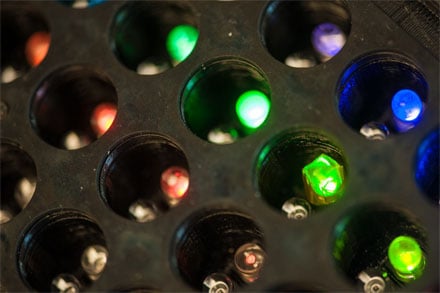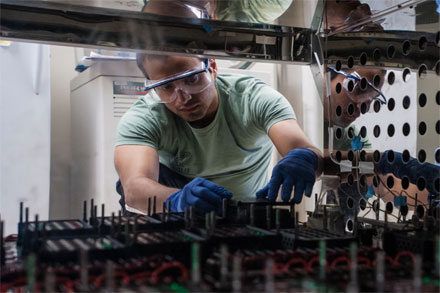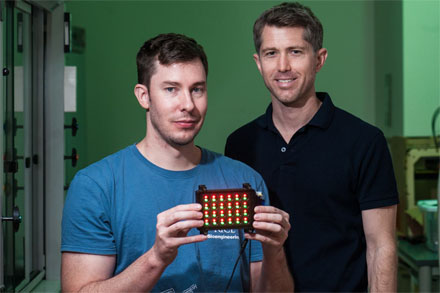An optogenetics platform has been developed using open-source hardware and software. The platform is available for biologists who want to incorporate optogenetics testing in their own labs and may reduce the entry barrier to optogenetics and photobiology experiments.

Rice University's low-cost, open-source Light Plate Apparatus can be used easily by nonengineers and noncomputer programmers and can be assembled by a nonexpert in one day. Courtesy of Jeff Fitlow/Rice University.
Called the Light Plate Apparatus (LPA), the open source device can deliver two independent 310 to 1550 nm light signals to each well of a standard 24-well plate and provide intensity control and millisecond resolution. The device offers the ability to swap out LEDs and will accept LEDs of wavelengths ranging from blue to far red. Signals are programmed into the device using an intuitive web tool.
Total component costs for the LPA are approximately $400 and may be significantly less for labs with a 3D printer. The LPA device is designed to be assembled and calibrated by a nonexpert in just one day.
The LPA platform was developed by a research team at Rice University.
Team member Karl Gerhardt was initially interested in creating a means to incorporate optogenetics in his own research. A fellow student had created the light tube array (LTA), an automated system for doing optogenetics on up to 64 test tubes at a time. LTA could not be used for Gerhardt’s experiments; the research team, whose combined background includes electrical engineering, physics, programming and website design, decided to make it better. The team kept innovating and coming up with new versions of the hardware, adding a low-cost microcontroller with a Secure Digital card reader and drivers capable of producing more than 4,000 levels of light intensity and millisecond time control.

Rice University graduate student Sebastián Castillo-Hair conducts tests with the Light Plate Apparatus, an open-source optogenetics research platform developed in the laboratory of Rice's Jeffrey Tabor, assistant professor of bioengineering. Courtesy of Jeff Fitlow/Rice University.
The team made most of the parts for the LPA using 3D printers. They developed a graphical user interface, called Iris, which uses simple buttons and pull-down menus to allow users to program the device for a wide range of experiments without the need for specialized computer training.

To demonstrate the broad applicability of LPA, the researchers conducted optogenetic gene expression control experiments, using the system to precisely control blue, green and red light-responsive optogenetic tools in gut bacteria, yeast and mammalian cells and to simplify the entrainment of cyanobacterial circadian rhythm.
The LPA was designed to be compatible with a wide range of optogenetics and photobiology experiments and model organisms; to be low-cost, scalable; and to be a high throughput device that could be used by laboratories without hardware expertise. Because the LPA and Iris are open source, they may be freely modified and extended by the community for additional functionality.

Rice bioengineers Karl Gerhardt (left) and Jeffrey Tabor with the Light Plate Apparatus, a low-cost, open-source optogenetics platform. Courtesy of Jeff Fitlow/Rice University.
"Our intent is to bring optogenetics to any researcher interested in using it," said professor Jeffrey Tabor.
"Over the past five to 10 years, practically every biological process has been put under optogenetics control," said Gerhardt. "The problem is that while everyone has been developing the biological tools to do optogenetics — the light-sensing proteins, gene-expression systems, protein interactions, etc. — outside of neuroscience, no one has really developed good hardware that makes it easy to use those tools."
To simplify the process of getting started with LPA, the researchers have published all the software, design files and specifications for the system on GitHub.
Gerhardt said at least a half-dozen research groups began making LPAs after an early version of the paper was posted on a biology preprint server.
"I hope this becomes the standard format for doing general optogenetics experiments, especially for people on the biology end of the spectrum who would never think about building their own hardware," Gerhardt said. "I hope they'll see this and say, 'OK. We can do optogenetics now.'"
The research was published in Scientific Reports (doi:10.1038/srep35363).